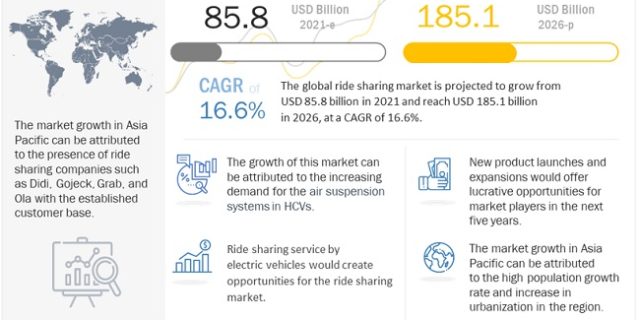
The forecasted period predicts a significant growth of the global Ride-Sharing Market, with a Compound Annual Growth Rate (CAGR) of 16.6%. The market value is expected to increase from approximately USD 85.8 billion in 2021 to USD 185.1 billion by 2026.
The ride-sharing market is experiencing growth due to several factors. These include the rise in daily commuting for short-distance travel within cities, escalating fuel prices, declining quality of public transportation services, and increasing traffic congestion in urban areas. Various ride-sharing options such as e-hailing, carpooling, and micro-mobility services like bicycles, e-bikes, electric mopeds, and scooters are contributing to the expansion of this market. Additionally, the availability of affordable internet and smartphones, especially in developing countries like China, India, and Indonesia, has made accessing ride-sharing services more convenient, further driving the industry’s growth.
Within the ride-sharing market, the car sharing segment is expected to grow at a faster rate. Car sharing is an affordable and convenient mobility service that allows multiple individuals to commute together and share travel costs. This service is particularly designed for shorter trips and one-way commutes. Factors contributing to the growth of car sharing include an increasing daily commute to workplaces, the desire to save fuel wasted during traffic congestion, and the opportunity to provide rides to colleagues and fellow commuters heading in the same direction. Key players in the car-sharing market include BlaBlaCar, Togo, Talixo, Car2go, and DriveNow.
Request Sample Report: https://www.marketsandmarkets.com/requestsampleNew.asp?id=198699113
In terms of vehicle types, internal combustion engine (ICE) vehicles dominate the global ride-sharing market. These vehicles are cost-effective to purchase, operate, and maintain, making them popular choices for ride-sharing services. IC engine vehicles are used in various ride-sharing models, such as e-hailing, car sharing, and car rental services. Drivers prefer IC engine vehicles for e-hailing due to their easy refueling and the abundance of fueling stations. Car sharing is mainly done with personally owned vehicles, and since most people own IC engine vehicles, they are commonly utilized. Car rental services also rely on ICE vehicles as they are suitable for long-distance trips, while electric vehicles may require frequent charging. However, as there is a growing focus on reducing carbon emissions and preserving fossil fuels, the ride-sharing market is expected to witness an increase in electric vehicles’ presence, potentially reducing the share of ICE vehicles in the coming years.
Among the various services provided in the ride-sharing market, navigation technology plays a dominant role. Navigation services guide drivers and passengers in terms of location and route selection, while mapping and traffic data enhance the overall user experience. Ride-sharing companies aim to increase profitability and may develop their own navigation services to reduce costs. For instance, Uber has its navigation app, Uber Nav, specifically designed for drivers using the Uber platform. This built-in GPS app simplifies the driving process for Uber drivers and is compatible with any smart device running the Uber app. Navigation services are essential in the ride-sharing industry, and as the number of ride-sharing users continues to grow, the demand for navigation data services is expected to increase.
Inquire Before Buying: https://www.marketsandmarkets.com/Enquiry_Before_BuyingNew.asp?id=198699113
In terms of regional markets, North America is projected to be the second-largest ride-sharing market. The growth in North America can be attributed to collaborations between Original Equipment Manufacturers (OEMs) and ride-sharing service providers, increased internet penetration, the preference of millennials for ride-sharing services, and advancements in semi-autonomous and autonomous vehicles. Factors such as rising concerns about air pollution levels and significant investments by major players in the market also contribute positively to the North American ride-sharing market. Additionally, organizations like the US Department of Transportation Research and Innovative Technology Administration (RITA) focus on research and development in smart public transportation. With a high population and a heavy reliance on public transit in North America, there is a strong demand for an effective ride-sharing management system. The region is home to major ride-sharing companies such as Uber, Lyft, Waze, Bird, Lime, and Avis.
Related Reports:
Automotive Chassis Market – Global Forecast to 2025
Automotive Hydrostatic Fan Drive System Market – Global Forecast to 2025
Automotive Acoustic Engineering Services Market – Global Forecast to 2025

